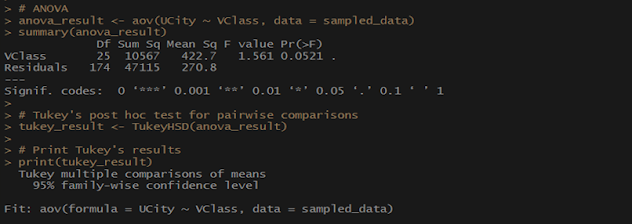Final Project: Comparative Analysis of Fuel Efficiency in Various Vehicle Types
Step 1: Choosing a Dataset
Dataset: Fuel Economy Data from the
US Department of Energy (http://www.fueleconomy.gov/feg/download.shtm)
Step 2: Sampling and Hypothesis
Sample Size: 250 vehicles
Null Hypothesis (H0): There is no
significant difference in fuel efficiency between different vehicle types.
Alternative Hypothesis (H1): There
is a significant difference in fuel efficiency (MPG/City) between different
vehicle types.
Step 3: Write-up Summary
This study aims to determine
whether different types of vehicles have statistically significant differences
in fuel efficiency. Customers place a high value on fuel economy, and knowledge
about the capabilities of various car models can help lawmakers and consumers
alike.
This study is consistent with what
was discussed in class on analysis of variance (ANOVA) and hypothesis testing.
The groundwork for choosing suitable statistical techniques to evaluate the
differences in fuel efficiency between various car models has been laid by
previously discussed subjects in class.
I will utilize an ANOVA to answer
the study question. An analysis of variances in fuel economy between different
types of vehicles can be done effectively with ANOVA since it permits the
comparison of means across numerous groups. The type of vehicle (compact, SUV,
etc.) is the categorical variable, and fuel efficiency is the continuous
variable.
The
following R code was used to conduct the ANOVA variance analysis:
Step 4: Generate Visualization and Abstract
Visualization
To show the distribution of fuel
efficiency for each type of vehicle, I created a boxplot. A clear comparison of
the fuel efficiency distribution and central tendency across different vehicle
types was made possible by this graphical approach.
The purpose of this study is to determine
whether there are any statistically significant differences in fuel efficiency
across different vehicle classes using ANOVA. The boxplot provides insights
into the possible effects on customers and the car industry by graphically
illustrating the difference in fuel efficiency. The results will advance our
knowledge of how different car models differ in terms of fuel efficiency, which
will have consequences for consumer decisions as well as environmental
concerns.




No comments:
Post a Comment